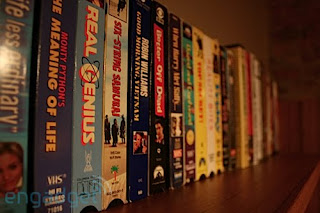Gah?
Having shuddered involuntarily at the giga-geek in the mirror, let’s get back to the idea of the project itself, which is basically that the things you like (or dislike) are important parts of who you are. Of all the books or movies or albums or websites or whatnot ever produced by humankind, a certain segment are the ones I think are the best, or the ones I think everyone else should be exposed to, or the ones I find personally inspirational. And a social forum dedicated to sharing and riffing off those specific sub-groupings of our common culture seems like a good idea.
Of course, for my buddy and I to get this project off the ground, we have to standardize the points of reference. OK, technically, we don’t have to, because we could accomplish the minimal goal of getting people talking about what seemingly benign movies totally gave them nightmares as kids or what kind of playlist would be essential for driving cross-country just by e-mailing a bunch of people and asking them to hit Reply All when answering the question. But if we want to not only get the conversation going and keep it going but also break it all down along the way with nuggets like “78% of people really do think Happy Days is an overrated TV show!” then we need to start with a standardized database so we can take advantage of computer processing of data instead of figuring it all out by hand. (To me this seems pretty inherently obvious because leveraging data in databases is my whole wage-earning job, so I’m just going to leave it at that assertion. If you don’t quite follow, just trust me on this one.)
(Also I’m all for job creation in order to stimulate the economy and all that but why is the 2010 census not being conducted mostly online? Seriously?)
So my buddy and I are still working out the details of our grand plan here, which seems like a good idea on paper but may or may not be tenable in execution. One thing we’ve been wrestling with is the following scenario: we pose a question like “what movies are your equivalent of comfort food for your brain?” and encourage people to answer it, and some people have ready answers but others might need a little thought-prompting. So, logically, we would give them the ability to browse the database of movies we set up ahead of time. Except … what’s the best way to browse a list of (ideally) “every movie ever made”?
I have no answer to that question at the moment. But what I do have are some childhood memories that I hadn’t thought about in ages until that scenario came up. Childhood memories of the dawning of the VHS era and the Age of Video Stores.
It’s strange to recall given the improbably deep reserves of material available via every outlet from Netflix to Amazon, but when VHS was first catching on, retail businesses had to build up their stocks from nothing. The scope of a mom-and-pop video rental store’s collection might be vast or slight, and even for the ones that somehow quickly built up to vast territory faced another challenge, which was how to convey the vastness. Hundreds, even thousands of VHS cassettes stored spines-out on narrowly spaced industrial shelves didn’t take up that much room, but at the same time weren’t very inviting. On the other hand, putting a bunch of clamshell cases on the wall face-front made perusing the offerings a bit more enticing, but if the video store was in a strip mall, space was at a premium, and there was no way the entire stock could be shown off that way.

I have a distinct memory of being at my grandparents’ house at the beach, and my parents planning to go out for the evening to take advantage of Grandma and Grandpa as babysitters. My brother and I were allowed to pick a couple of movies to rent to amuse ourselves (and presumably make G&G’s caretaking task that much easier). My grandparents, like my parents, were pretty early adopters of technology like cable tv and VCRs, so Grandma already was a steady customer at a local video store, and had brought home a copy of their catalog, which I also distinctly remember. It was black and white, printed on really low-grade newsprint, in two or three columns of teeny-tiny text, like the phone book. (Hey, remember phone books?) It wasn’t terribly hefty, maybe about the size of the TV Week that comes with the Sunday newspaper. But, as I mentioned, the text was dense. And it was just an alphabetical listing of every movie the store had a VHS copy of, categorized along the lines of “comedy”, “romance”, “action”, “children’s”, etc. And I remember poring over this list scanning for titles of movies that I wanted to ask Grandma to rent. I also remember my Little Bro taking one look at the cramped columns of titles, uninterrupted by pictures or anything, and saying “Ugh. You do it!” and shoving the catalog at me. It really was a cumbersome and onerous way of going about picking a movie, but I took to the task with great seriousness, because that’s just the kind of little geek I apparently always have been. (To be fair to the analog technologies of yesteryear, I know the print catalog system was not really designed with indecisive children in mind. Presumably an adult would think to themselves, “I’d like to watch The Sting tomorrow night, I wonder if Beachcomber Video has a copy?” and flip to the appropriate page for a yes/no verdict. But as a kid who’s most frequent response to “what do you want?” was “what do they have?”, I made use of the information available in the format provided.)
As if my young geekiness cred needed any more burnishing, I’m pretty sure the movie we ended up renting was TRON.















